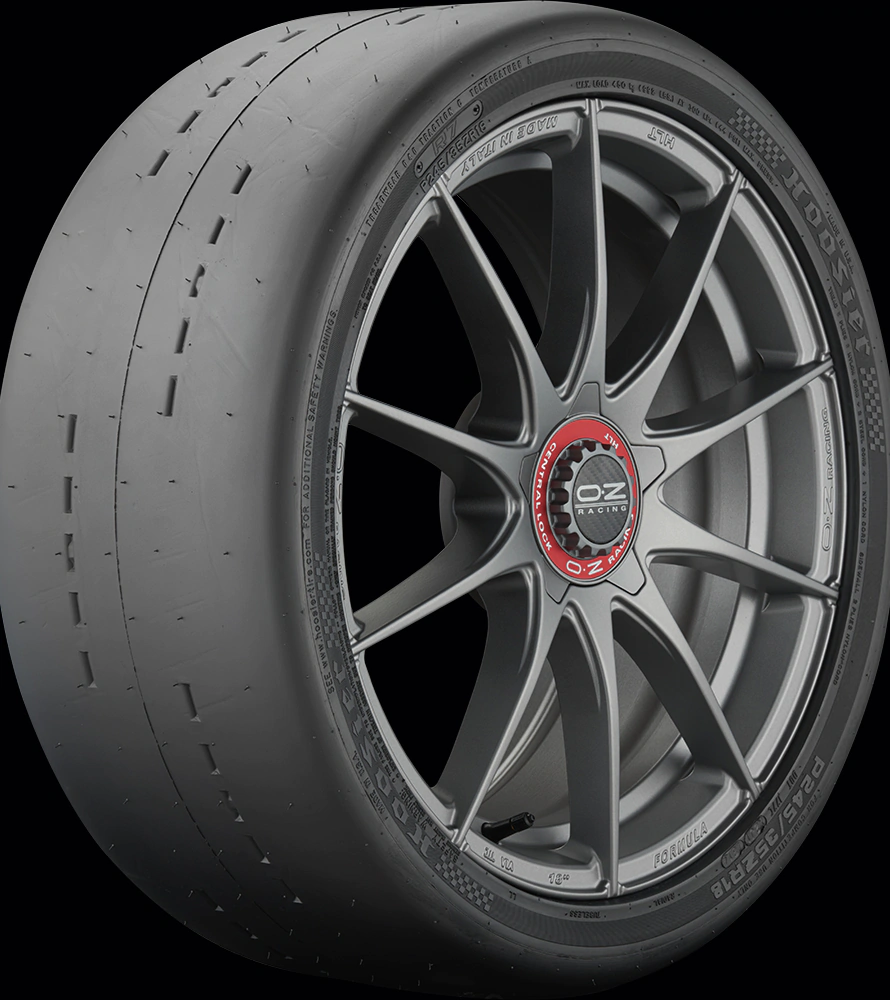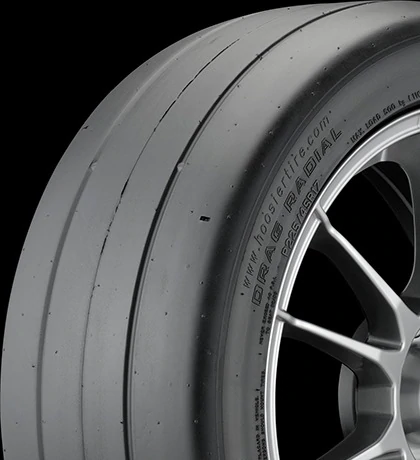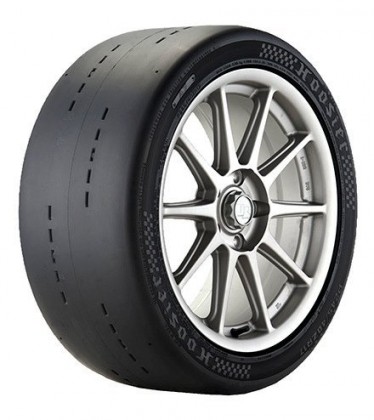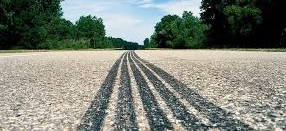More About this Tire Manufacturer: Hoosier Tires
Lakeville IN 46536
800 (574) 784-3152
Hoosier Racing Tire Sports Car DOT A7 Radials are Racetrack & Autocross Only tires developed for drivers who compete in autocross, time trial and hillclimb events in dry conditions where responsiveness and high levels of grip at lower operating temperatures are desirable. A7 Radials are also used for road racing on lightweight cars or when competing in cool ambient temperatures where Hoosier Sports Car DOT R6 Radials cannot be brought up to favorable operating temperatures.
WARNING: DOT labeled Hoosier Racing Tires meet Department of Transportation requirements for marking and performance only and are NOT INTENDED FOR HIGHWAY USE. It is unsafe to operate any Hoosier Racing Tire, including DOT tires, on public roads. The prohibited use of Hoosier Racing Tires on public roadways may result in loss of traction, unexpected loss of vehicle control, or sudden loss of tire pressure, resulting in a vehicle crash and possible injury or death.
And like all Racetrack & Autocross Only tires, A7 Radials are not intended to be driven in near-freezing temperatures, through snow or on ice. It's also essential these tires be stored indoors at temperatures maintained above 32 degrees F.
Sports Car DOT A7 Radials incorporate a new tread compound designed to extend wear and useable heat cycles, as well as experience less "fall-off" during a long run and less degradation over the life of the tire (compared to A6 tires). The tread compound is molded into a slick tread design interrupted only by five-dash circumferentially oriented grooves alternating outboard and inboard. Beginning with a tread depth of 4/32", they will not require shaving for competition, however they will benefit from a minimal scuff-in prior to their first runs.
The tire's internal structure features a symmetric construction that uses two lightweight steel belts reinforced by a spirally wrapped circumferential nylon cap ply under the tread on top of two nylon cord casing plies. It features a rim recess design on all sizes. Additionally, its symmetric tread design and internal construction allows the tire to be mounted on either side of the car (and later be remounted inside out to further extend its life).
Because of the way tires are manufactured, taking measurements of unmounted tires does not provide an accurate comparison. Hoosier DOT-radials typically have very generous unmounted dimensions, so be sure to mount on appropriate-width wheels before making any judgment related to physical size.
The section width, tread width and shoulder profile of the A7 may differ from those of its predecessor, affecting the clearance between the tire and suspension components and/or body panels. If the intended application is an aggressive fitment with close tolerances, it is recommended to test fit a mounted, inflated tire to check for potential contact between the tire and vehicle before driving on the tires.
|
Performance Category: Radetrack & Autocross Only
None
Treadlife Warranty: None
Road Hazard Warranty: None
Workmanship & Materials Warranty: None
None
|
Hoosier Racing Tire Sports Car DOT Radial R7 tires are Racetrack & Autocross Only tires developed for drivers who compete in road racing where responsiveness and high levels of grip in hot, dry conditions are desirable. Radial R7 tires are designed to reward drivers with fast, consistent lap times and extended wear due to their traction and handling.
NOTE: Radial A7 tires are also used for road racing on lightweight cars or when competing in cool ambient temperatures where Hoosier Sports Car DOT Radial R7 tires cannot be brought up to favorable operating temperatures.
WARNING: DOT labeled Hoosier Racing Tires meet Department of Transportation requirements for marking and performance only and are NOT INTENDED FOR HIGHWAY USE. It is unsafe to operate any Hoosier Racing Tire, including DOT tires, on public roads. The prohibited use of Hoosier Racing Tires on public roadways may result in loss of traction, unexpected loss of vehicle control, or sudden loss of tire pressure, resulting in a vehicle crash and possible injury or death.
And like all Racetrack & Autocross Only tires, R7 Radials are not intended to be driven in near-freezing temperatures, through snow or on ice. It's also essential these tires be stored indoors at temperatures maintained above 32 degrees F.
The tread compound of Sports Car DOT R7 Radials is molded into a slick tread design interrupted only by five-dash circumferentially oriented grooves alternating outboard and inboard. Beginning with a tread depth of 4/32", they will not require shaving for competition, however they will benefit from a minimal scuff-in prior to their first runs.
The tire's internal structure features a symmetric construction that uses two lightweight steel belts reinforced by a spirally wrapped circumferential nylon cap ply under the tread on top of two nylon cord casing plies. It features a rim recess design on all sizes. Additionally, its symmetric tread design and internal construction allows the tire to be mounted on either side of the car (and later be remounted inside out to further extend its life).
Because of the way tires are manufactured, taking measurements of unmounted tires does not provide an accurate comparison. Hoosier DOT-radials typically have very generous unmounted dimensions, so be sure to mount on appropriate-width wheels before making any judgment related to physical size.
The section width, tread width and shoulder profile of the R7 may differ from those of its predecessor, affecting the clearance between the tire and suspension components and/or body panels. If the intended application is an aggressive fitment with close tolerances, it is recommended to test fit a mounted, inflated tire to check for potential contact between the tire and vehicle before driving on the tires.
|
Performance Category: Radetrack & Autocross Only
None
Treadlife Warranty: None
Road Hazard Warranty: None
Workmanship & Materials Warranty: None
None
|
The Sports Car DOT Radial Wet H20 is Hoosier's Wet Racetrack & Autocross Only tire developed for drivers who participate in autocross and road racing events in moderate to heavy rain.
WARNING: DOT labeled Hoosier Racing Tires meet Department of Transportation requirements for marking and performance only and are NOT INTENDED FOR HIGHWAY USE. It is unsafe to operate any Hoosier Racing Tire, including DOT tires, on public roads. The prohibited use of Hoosier Racing Tires on public roadways may result in loss of traction, unexpected loss of vehicle control, or sudden loss of tire pressure, resulting in a vehicle crash and possible injury or death.
And like all Wet Racetrack & Autocross Only tires, Radial Wet H2O radials are not intended to be driven in near-freezing temperatures, through snow or on ice. It's also essential these tires be stored indoors at temperatures maintained above 32 degrees F.
Sports Car DOT - Radial Wet H20 tires feature an aromatic oil-free wet weather tread compound that offers traction for fast and consistent lap times in wet track conditions, along with improved treadwear and durability in damp to drying track conditions. This compound is molded into a directional tread design featuring a combination of circumferential and "Y-shaped" lateral tread grooves. Through the initial portion of their life (between their beginning tread depth of 8/32-inch and approximately 4/32-inch of remaining tread depth), the walls of the tread grooves taper as the tires wear. Through the remainder of their tread depth (between 4/32-inch tread depth and worn out), the walls are molded vertically. This allows the tires to serve as full wet tires when used at their original 8/32-inch tread depth, or intermediate wet tires when shaved or worn to approximately 4/32-inch of remaining tread depth due to the reduced tread squirm and increased footprint contact area.
Sports Car DOT - Radial Wet H20 tires have a symmetric internal construction and directional tread design that allow them to be mounted for use on either side of the car. The tire's internal structure features a three-ply nylon cord radial casing reinforced by two fiberglass belts and a spirally wound circumferential nylon cap ply under the tread.
|
Performance Category: Wet Racetrack & Autocross Only
None
Treadlife Warranty: None
Road Hazard Warranty: None
Workmanship & Materials Warranty: None
None
|
The D.O.T. Drag Radial is Hoosier's Drag Racing Radial tire developed for drag racers that compete in sanctioned events at local strips. D.O.T. Drag Radials feature Hoosier's race-proven technology and compounds, making them ideal for competition classes that require street-legal tires.
Now offering a choice of tire sidewall styling treatments, the Hoosier logo is crisply painted in solid white letters on one sidewall of D.O.T. Drag Radial tires for competitors who want to proudly proclaim their tire choice to fellow drag racers and fans.
WARNING: DOT labeled Hoosier Racing Tires meet Department of Transportation requirements for marking and performance only and are NOT INTENDED FOR HIGHWAY USE. It is unsafe to operate any Hoosier Racing Tire, including DOT tires, on public roads. The prohibited use of Hoosier Racing Tires on public roadways may result in loss of traction, unexpected loss of vehicle control, or sudden loss of tire pressure, resulting in a vehicle crash and possible injury or death.
And like all Drag Racing Radial tires, D.O.T. Drag Radials are not intended to be driven in near-freezing temperatures, through snow or on ice. It's also essential these tires be stored indoors at temperatures maintained above 40 degrees F.
D.O.T. Drag Radials feature a special tread compound molded into a "slick" tread design featuring two symmetric circumferential tread grooves. Beginning with just 4.5/32" tread depth, they are ready for competition after being scuffed-in. The tire's symmetric internal construction features nylon cord casing plies reinforced by two lightweight steel belts and spirally wrapped nylon reinforcement under the tread.
Hoosier's burnout procedure for most cars recommends rolling through the water box to wet the tires. Start the burnout. However, once the tires begin to "haze", slow the burnout and proceed to the start line. The burnout's goal is to clean all debris off the tires and heat just the surface of the tread. Since most wear to the tread life of a drag tire comes from too much time in the burnout procedure, shorten the burnout time in the water box if you feel you are getting too much wear.
The D.O.T. Drag Radial's symmetric tread design and internal construction allows them to be installed on either side of the car. Hoosier suggests swapping tires from side-to-side on a regular basis to help smooth out and/or even treadwear. Side-to-side swapping also allows tires to run in both directions, thus causing the tire to wear differently, which helps clean up the tread. The tread surface should have a fine grain or velvet look.
The useful life of a tire, whether mounted or dismounted, is directly affected by storage conditions. Tires should always be stored indoors in a dark, cool, dry room. Remove the tires from the vehicle. Release the air pressure and lay the tires on their sides. Maintain the temperature range in the storage location between 40-90 degrees Fahrenheit. Don't store tires in sub-freezing temperatures for any length of time, as it will cause the rubber to freeze and possible crack.
|
Performance Category: Drag Racing Radials
None
Treadlife Warranty: None
Road Hazard Warranty: None
Workmanship & Materials Warranty: None
None
|
The D.O.T. Drag Radial 2 is Hoosier's redesigned Drag Racing Radial tire developed for drag racers that compete in sanctioned events at local strips. D.O.T. Drag Radials feature Hoosier's race-proven technology and compounds, making them ideal for competition classes that require street-legal tires.
WARNING: D.O.T. labeled Hoosier Racing Tires meet Department of Transportation requirements for marking and performance only and are NOT INTENDED FOR HIGHWAY USE. It is unsafe to operate any Hoosier Racing Tire, including DOT tires, on public roads. The prohibited use of Hoosier Racing Tires on public roadways may result in loss of traction, unexpected loss of vehicle control, or sudden loss of tire pressure, resulting in a vehicle crash and possible injury or death.
And like other Track & Competition DOT tires, these tires are not intended to be stored, serviced or driven in near- or below freezing temperatures, through snow or on ice.
D.O.T. Drag Radial 2 tires feature a special tread compound molded into a slick tread design interrupted only by five-dash circumferentially oriented grooves alternating outboard and inboard. Beginning with a molded tread depth of just 4/32", they are ready for competition after being scuffed-in. The tire features an improved tread profile to help deliver the best performance results. Its internal structure features symmetric nylon cord casing plies reinforced by two lightweight belts and spirally wrapped nylon reinforcement under the tread.
Hoosier's burnout procedure for most cars recommends rolling through the water box to wet the tires. Start the burnout. However once the tires begin to "haze", slow the burnout and proceed to the start line. The burnout's goal is to clean all debris off the tires and heat just the surface of the tread. Since most wear to the treadlife of a drag tire comes from too much time in the burnout procedure, shorten burnout time in the water box if you feel you are getting too much wear.
The D.O.T. Drag Radial 2's symmetric tread design and internal construction allows them to be installed on either side of the car. Hoosier suggests swapping tires from side-to-side on a regular basis to help smooth out and/or even treadwear. Side-to-side swapping also allows tires to run in both directions, thus causing the tire to wear differently, which helps clean up the tread. The tread surface should have a fine grain or velvet look.
The useful life of a tire, whether mounted or dismounted, is directly affected by storage conditions. Tires should always be stored indoors in a dark, cool, dry room. Remove the tires from the vehicle. Release the air pressure and lay the tires on their sides. Maintain the temperature range in the storage location between 40-90 degrees Fahrenheit. Don't store tires in sub-freezing temperatures for any length of time, as it will cause the rubber to freeze and possibly crack.
|
Performance Category: Drag Racing Radials
None
Treadlife Warranty: None
Road Hazard Warranty: None
Workmanship & Materials Warranty: None
None
|
The history of Hoosier Tire is one of an American Dream come true for two young, Indiana entrepreneurs who turned a personal vision into a reality. Bob and Joyce Newton after winning the South Bend track championship in 1952
It all began back in the early 50's when Robert "Bob" Newton, along with his supportive wife Joyce, began a successful racing career on the small asphalt tracks of northern Indiana. Bob, like many of his fellow drivers, was not satisfied with driving on street tires with their limited sizing options and uniformly hard tread compounds. It was during these early days of "eating bologna sandwiches and sleeping on a creeper under his racer" that Bob had a vision to produce his own tires specifically designed for racing. Hoosier's 1st "factory" where re-caps were produced.
So, in 1957, Bob and Joyce decided to begin producing their own race tires by re-treading street tires with softer compounds. They began their business in an old abandoned horse barn in South Bend, Indiana, selling their tires to local racers. The "Hoosier" name was chosen for their company to reflect the origin of Bob's racing roots on the short tracks of the Midwest. The company color of purple came from Bob's #4 race car.
While the company had just two employees at first, it wasn't long before the business began to grow. Soon family members, friends and neighbors were being recruited to re-tread tires. As the fledgling company began to master the available tire-making technologies, they set their sights on producing their first race tire specifically designed for racing. And so, in 1962, Bob Newton did just that through an arrangement with the Mohawk Rubber Company in Akron, Ohio. For the next 16 years, Bob commuted from northern Indiana to Akron to design, engineer, compound and oversee the production of his tires. Hoosier's 1st "new tire" factory.
Then, on Thanksgiving weekend in 1978, the Newtons were delivered news that could have ended the ever-expanding business that their small work force had worked so hard to develop. Mohawk was closing the Akron plant and, as a result, was about to end their ability to produce new race tires. Faced with this potentially devastating news, Bob and Joyce made a decision that has changed the face of racing forever. With their long association with the local bank, they were able to mortgage their home and Hoosier Tire to raise the capital needed to build the world's first and only factory solely devoted to the production of racing tires. Located in Plymouth, Indiana, just down the road from the corporate office in Lakeville, the factory began production in 1979 with just a handful of employees under the name "R & J Mfg. Corp." (for Robert and Joyce).
During the early years of R & J, the secret rubber formulas required to produce Hoosier tires were still being produced by outside suppliers. Finally, in 1985, as the business continued to grow, the Newtons were determined to eliminate the need to rely on outside rubber suppliers by developing the company's own in-house rubber production capabilities. So, it was back to the bank to obtain financing for the first million dollar mixing plant to produce rubber compounds strictly for racing tires. The equipment purchased included the latest computer controlled "Banbury" to mix the complicated racing compounds as well as the components for an advanced testing and technology center. Bob Newton & Neil Bonnett in victory lane in March 1988 at Rockingham.
The Hoosier name, while well known in the racing community by the late '80s, was not yet a nationally or internationally recognized name. Then, in 1988, the company went Winston Cup racing, taking on the "Goliath" of the tire business. Hoosier, in its first year of competition in the series, went on to capture 9 victories and worldwide fame. The following year, Hoosier tires were on the winning car in the grand-daddy of all races, the Daytona 500. While this success was on a bias-ply tire, work had already begun at Hoosier on producing a radial tire that would work in racing applications. Calender Operation
In 1991, after three years of research and development, Hoosier introduced its own radial race tire into the Busch Grand National series with great success. That same year, Bob took his vision of complete in-house control of the manufacturing processes needed to produce Hoosier tires one step further. The company purchased a multi-million dollar, one-of-a-kind, new four-roll "Z" calender to go into an equally new state-of-the-art calendering facility next to the existing mixing plant. This innovation allowed Hoosier to apply rubber directly onto its own specially woven fabrics while maintaining the very tight tolerances that their engineers needed to build tires that would perform under the extreme speeds and high heat of racing. Jeff Bodine at Daytona - 1994
In 1992, Hoosier took another bold step and decided to build its second tire building plant in preparation for the company's return to NASCAR's Winston Cup series. This tire plant was solely devoted to the manufacture of tubeless radial race tires constructed with inner safety shields and designed to run on super speedway tracks at speeds in excess of 200 mph. In 1994, after three successful seasons in the Busch series, the company made the move up to the premier NASCAR Winston Cup series where it went on to enjoy its most successful season to that time. In that year, the talented Geoff Bodine claimed victory on Hoosier's innovative radial race tires four times in the #7 Exide Battery / Montgomery Ward "Auto Express" Ford.
The following year, Hoosier attempted to have NASCAR waive its "tire count rule" which required all participating tire manufacturers to bring enough tires to every race to supply the needs of all of the cars in the field. With this rule in place, Hoosier was required to produce roughly 2000 tires a week to sell only a few hundred during each event. This rule eventually proved too costly for the company to endure, so a financial decision was made to exit the top two NASCAR series, much to the displeasure of many racing fans. Despite this setback, Hoosier's overall success and growth in the industry continued. Bob Newton on the cover of Indiana Business Magazine (August 1995 issue)
In 1995, Hoosier was chosen as the sole supplier for all series events for the Automobile Racing Club of America (ARCA). This allowed Hoosier to continue developing tires for super speedway tracks. Also, the funding which had been used in the Winston Cup and Busch series was now available to assist an explosive growth plan which the company initiated at this time. Over the next several years, additional professional staff were added, including more engineers, compounders, product managers and track support personnel. The company financed further plant expansions and added more equipment. More production personnel and administrative staff were hired. All of this allowed the company to continue participating in its existing racing venues even as it penetrated additional markets while still assuring all of its customers a reliable supply of high quality racing tires. Arial view of Hoosier Tire & Rubber Corp.
In 1998, Bob and Joyce made the decision to re-name "R & J Mfg. Corp.," the manufacturing side of their growing company, as "Hoosier Tire & Rubber Corp." This removed the shroud of secrecy which the company had maintained within the community and industry concerning its manufacturing base.
In 1999, 15-time Pennzoil World of Outlaws champion Steve Kinser signed a 2-year agreement to exclusively run Hoosier tires in 2000 and 2001. "The King of the Outlaws" went on to capture an unprecedented 16th series championship his first year running the Hoosier brand. This also allowed Hoosier to lay claim to their first Pennzoil World of Outlaws championship title in the history of the company. The success of Kinser and Hoosier during the 2000 campaign was recognized by the National Sprint Car Hall of Fame Museum with Steve Kinser being awarded the "Driver of the Year" award while Hoosier President and CEO, Bob Newton, was awarded the "Builder/Manufacturer of the Year" award.
The turn of the century also saw Hoosier Tire & Rubber Corp. complete a massive multi-year plant consolidation and upgrade program which brought all operations together into one sprawling complex. Through the dedication and hard work of countless people within the Hoosier organization, the 3-year project was completed in just 18 months.
In 2012, the decision was made to bring both the manufacturing arm in Plymouth and the sales and marketing arm in Lakeville together under one corporate identity. It was at this time that the manufacturing facility (Hoosier Tire & Rubber Corp.) was renamed Hoosier Racing Tire Corp. Arial view of Hoosier Racing Tire Corp.
Today, Hoosier Racing Tire Corp. is the largest race tire manufacturer in the world and all Hoosier race tires are still proudly "Made in the USA." The company continues to be privately owned and operated by the Newton family, co-founder Joyce Newton along with many of the Newton family members remain actively involved in the day-to-day operations of Hoosier. Hoosier has grown to be one of the largest employers in Plymouth, Indiana producing over 1000 different types of race tires. The company has its own 300-mph test wheel; a technology center; state-of-the-art, fully-integrated production facilities recently adding a high-tech mixing plant, with enough capacity to produce not only for Hoosier Racing Tire, but to have the ability to produce rubber for additional entities; not to mention a model sales and distribution network in Lakeville, Indiana which others seek to emulate.
The pride that exists among those associated with Hoosier "family" continues to be the focal point of the success the company has enjoyed over the years. Joyce and the Newton family, as well as others involved in the racing industry, marvel at the success and growth of the original business the Newtons started almost 60 years ago. At Hoosier, we know that if you build a company with talented, hardworking people who care, and produce a product that performs at an affordable price, you will satisfy the needs of your customers and both you and they will be winners. This philosophy has been, and will continue to be, the secret behind Hoosier's success in building "Tires Designed for Champions."
Kelly-Springfield Tire & Rubber Company has had a long and interesting history, starting with the founding in 1894 by Edwin Kelly. The company started by using partner, Arthur Grant's blueprint to manufacture the first successful carriage tire. Many companies tried to manufacture similar products, but none were able to reach the success of Grants design using wires to hold the tire on the wheel. In 1903, Firestone Tire & Rubber Co., B.F. Goodrich Co., the Goodyear Tire & Rubber Co., and dozens of other tire manufacturers purchased the license to start producing Grant's patent. The Great Depression was extremely hard to the Kelly-Springfield Tire & Rubber Company, dropping the sales 54% between 1929 and 1933. Edmund Burke saved the company from bankruptcy, reorganized the company, and sold them to Goodyear Tire & Rubber Company. Presently, Kelly manufacturing plants use the philosophy "first class or scrap" mentality. The company believes that if the tire is not the absolute best, it should be "scrapped" so that customers do not experience anything but the best. Today, the slogan used is "A good deal on a great tire."
The Navigator Gold is one of Kelly Tire's most popular tires. Navigator Gold is a smooth, quiet ride in all four seasons. A combination of isolated and interlocked tread elements are featured in the tire to enhance traction and handling in wet and dry conditions. To give the tire a smooth and quiet, comfortable ride, enhanced rubber distribution combined with alternating shoulder slots were incorporated in the design.
For light Trucks, the Safari Trex offers a premium all-terrain tire that has even-wearing tread, a quiet ride, and extreme ride comfort. The Safari Trex features many break through technologies including: an elongated rib and multi-pitch design, a unique tread pattern, element geometry, below-surface geometry and an enhanced cavity shape. For decreased noise, the elongated rib and multi-pitch tread design were used. The tread pattern and element geometry give the tire additional traction for deep snow and mud, but do not contribute to added tire noise. To keep rocks from penetrating the tread grooves, below-surface geometry was added to the design. An enhanced cavity shape maintains rectangular footprint shape to allow for even tread-wear giving the tire a longer life.
For an exceptional high-performance, all –season tire, chose the Charger GT. This tire has a sport-derived tread pattern that not only has a sporty appearance, but also increased handling. Twin circumferential grooves are featured to improve wet traction and handling. The Charger GT offers a 50,000-mile limited tread wear warranty guaranteeing a quality product.












